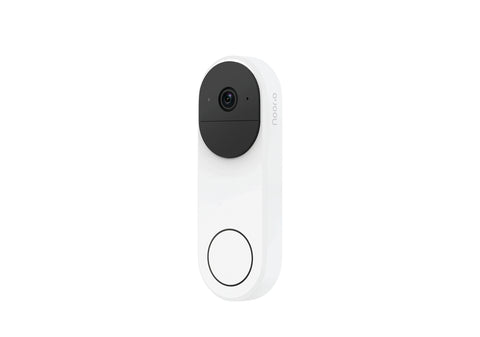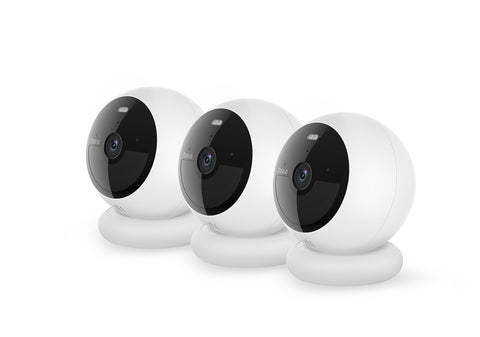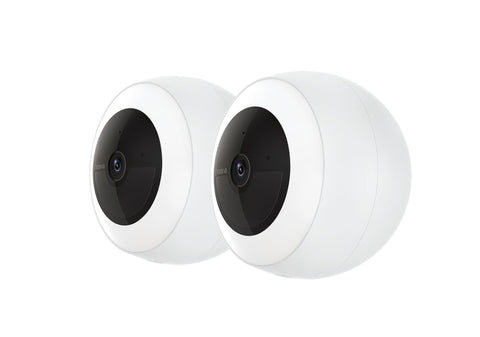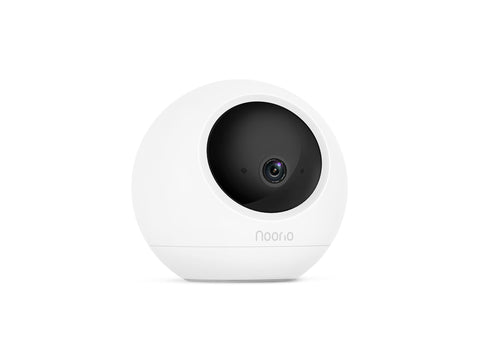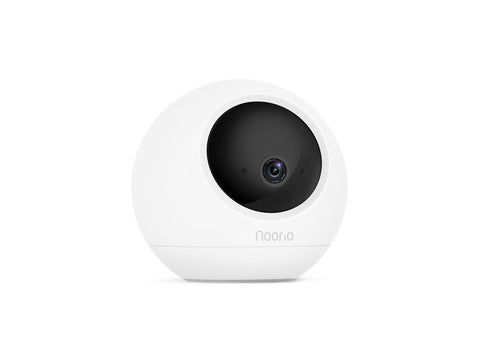The world of security cameras has expanded rapidly with technological advances, and today's consumers are spoiled with a plethora of options. One decision homeowners and businesses often grapple with is whether to choose a 2.4 GHz or 5 GHz Wi-Fi connection for their security cameras.
In this guide, we'll break down the differences between the two, the advantages and disadvantages, and provide recommendations to help you make the best choice for your security needs.
What Do 2.4 GHz and 5 GHz Mean?
Wi-Fi networks come in two main frequency bands: 2.4 GHz and 5 GHz. These numbers refer to the frequencies at which the wireless signals are transmitted. Think of them as two different lanes on the internet highway.
Each has its own set of characteristics, which can influence the performance of devices connected to them, including security cameras. If you don't know what your WiFi network is, check this blog.

Quicklook:
| 2.4GHz | 5GHz | |
|---|---|---|
| Video Quality | Up to 1080p HD | Up to 4K UHD |
| Latency | Higher | Lower |
| Reliability | Prone to interference | Minimal interference |
| Night Vision Range | Better penetration in darkness | More obstruction in darkness |
| Outdoor Wireless Range | Up to 300ft | Up to 150ft |
| Compatibility | Supports most cameras | Verify camera compatibility |
| Speed | Up to 300 Mbps | Up to 1300 Mbps |
| Frequency Band | 2.4 - 2.483 GHz | 5.15 - 5.25 GHz 5.25 - 5.35 GHz 5.47 - 5.725 GHz 5.725 - 5.85 GHz |
| Channels | 1 - 13 channels | Up to 19 non-overlapping channels |
| Congestion | High - Used by many devices | Low - Newer technology |
| Interference | High - Overlapping channels | Low - Non-overlapping channels |
| Wall Penetration | Good | Poor |
| Compatibility | Supports old and new devices | Mostly newer devices |
Pros of 2.4 GHz Wi-Fi for Your Security Systems
- Wider Range: One of the primary reasons many consumers lean towards the 2.4 GHz band is its ability to provide coverage over a more extended area. The longer wavelength means that signals have a better chance of passing through denser materials, such as thick walls, floors, and even some outdoor foliage. For homeowners with multi-level houses or basements, or those wanting to cover outdoor areas, this frequency often delivers more consistent connectivity.
- Compatibility: The 2.4 GHz band has historically been the standard for Wi-Fi, making it the "default" for many older devices. As a result, if you have a mix of older and newer devices in your ecosystem, sticking with 2.4 GHz might offer a smoother experience with fewer connection hiccups. This can be especially relevant for users who may be integrating older model security cameras or smart home devices.
- Less Congestion from Non-Wi-Fi Devices: In today's tech-savvy world, myriad devices and appliances transmit signals. Devices such as microwave ovens, cordless phones, and certain remote-controlled toys use frequencies that hover around 2.4 GHz. By using this same frequency for your security system, you can avoid potential interference from devices that might stray into the 5 GHz space.
Cons of 2.4 GHz Wi-Fi for Your Security Systems
- More Congestion from Wi-Fi Devices: While 2.4 GHz is less congested from non-Wi-Fi devices, the reverse is true for Wi-Fi ones. Since many households and businesses are teeming with devices operating on this frequency, there's a higher chance of interference, especially in densely populated areas or apartment complexes.
- Potentially Slower Speeds: Speed is often a trade-off with range. The 2.4 GHz frequency has fewer channels, and with potential overcrowding, data can be transmitted at a slower rate. This might be an issue if your security camera streams high-definition content or if multiple devices are accessing the network simultaneously.

Pros of 5 GHz Wi-Fi for Your Security Cameras
- Faster Speeds: A standout feature of the 5 GHz band is speed. Thanks to the availability of more channels and generally less congestion, data packets can be sent and received more rapidly. If your security system streams in HD or 4K, this frequency can handle the heavy lifting without breaking a sweat, ensuring crisp and timely footage.
- Less Interference: A significant boon of the 5 GHz band is its "cleanliness." With fewer devices (currently) operating in this space, there's less chance of other signals causing disruptions. This can be critical for security systems where every second counts and reliability is paramount.
- Better for Clustered Devices: Planning a centralized security hub? If multiple cameras are set up close together, for instance, in an office, store, or around a particular entry point, the 5 GHz band is ideal. It can manage data from several sources simultaneously without significant slowdowns or buffering.
Cons of 5 GHz Wi-Fi for Your Security Cameras
- Shorter Range: Speed often comes at the expense of range. The shorter wavelengths of the 5 GHz band find it harder to navigate thick walls, floors, or large obstructions. If your security setup is spread out or if there are several barriers to tackle, some blind spots might emerge.
- Limited Compatibility: As the newer kid on the block, the 5 GHz frequency isn't as universally adopted. This might pose challenges if you have older tech in your arsenal. Before transitioning, it's crucial to ensure all your devices can work seamlessly on this band to prevent unexpected incompatibilities.
How to Choose 2.4 GHz or 5 GHz Wi-Fi for My Security Cameras?
When assessing your environment, consider that the 2.4 GHz band has a longer range, reaching about 100 feet indoors. This makes it better suited for large homes where the network needs to penetrate multiple walls and obstacles to reach security cameras situated far away. However, for smaller spaces like apartments or offices, the shorter 30-50 foot indoor range of 5 GHz WiFi isn't as problematic. In these settings, the 5 GHz band is less likely to interfere with neighboring networks.

It's also important to take into account your camera specifications and resolution. If you have high-end 4K security cameras that capture extremely detailed footage, the extra bandwidth offered by 5 GHz WiFi is practically a necessity to transmit those large video files without lagging or interrupted streams. For 720p or 1080p HD resolution cameras, the 2.4 GHz band may still offer enough bandwidth in many cases, provided too many cameras are not streaming at the same time.
When thinking about future upgrades, keep in mind that the 5 GHz band provides more available channels. So, if you anticipate adding more smart home devices and WiFi cameras down the line, going with a router that supports 5 GHz will make it easier to add those without congesting your network. The 2.4 GHz band is more prone to interference as more devices are added, so 5 GHz offers more room to grow.
Common Issues When Choosing Wi-Fi Frequency
When deciding between 2.4 GHz and 5 GHz Wi-Fi for security cameras, users may encounter some common challenges:
- Limited range of 5 GHz affecting camera coverage - The shorter range may lead to blindspots if cameras are spread far apart.
- Interference from neighboring Wi-Fi networks on 2.4 GHz - Crowded areas like apartments often experience congestion and disrupted connectivity.
- Compatibility limitations of older cameras - Many older security cameras only work on 2.4 GHz networks. Upgrading can be expensive.
- Wall penetration challenges with 5 GHz signals - Materials like brick and concrete can inhibit signal passage to remote outdoor cameras.
- Insufficient bandwidth of 2.4 GHz for 4K cameras - High resolution footage requires the extra bandwidth and speed of 5 GHz.
Careful planning and testing can help identify and address these common Wi-Fi challenges when installing security cameras.

Checking Camera Compatibility
It's important to verify your security cameras will work on your chosen Wi-Fi band before purchase:
- Consult camera specs - Product manuals and specs will list compatible Wi-Fi standards like 802.11b/g/n for 2.4 GHz and 802.11a/ac for 5 GHz.
- Contact camera manufacturers - Many brands have tech support teams to confirm compatibility. They may also offer Wi-Fi adapters if needed.
- Test cameras onsite first if possible - Try cameras on a 2.4 GHz and 5 GHz network firsthand before permanent installation for peace of mind.
- Use a Wi-Fi analyzer - Apps like Wi-Fi SweetSpots detect all networks and devices in an area to identify possible sources of interference.
- Install a dual-band router - Having a router that supports both frequencies allows you to switch as needed if issues emerge after setup.
Doing the legwork to vet camera Wi-Fi compatibility will prevent headaches down the road and ensure optimal security system performance.
Tips for Choosing Between Frequencies
When deciding on 2.4 GHz or 5 GHz for your security cameras, keep these tips in mind:
- Give preference to 5 GHz for streaming high resolution footage and minimizing lag.
- Avoid crowded 2.4 GHz networks if possible to reduce interference and connectivity issues.
- Place cameras centrally if using 5 GHz to ensure they are within range.
- Use wired connections for distant cameras that struggle connecting wirelessly.
- Opt for dual-band routers to allow switching frequencies if needed after installation.
- Test thoroughly before permanent mounting to confirm cameras work properly on the selected band.
- Upgrade older cameras that only work on 2.4 GHz for maximum flexibility.
Choosing the ideal Wi-Fi frequency requires balancing your specific environment, camera capabilities and system needs. Following these tips will help implement a smooth and reliable wireless security camera setup.
Conclusion
Both 2.4 GHz and 5 GHz Wi-Fi frequencies offer unique advantages for security cameras. By understanding the needs of your space, the technical requirements of your cameras and considering future scalability, you can make an informed decision that ensures your security system runs smoothly and efficiently. Always remember the goal is to create a safe, secure, and reliable surveillance system tailored to your needs.
Read More
- Free Cloud Storage for Noorio Secrurity Camera. Save footage in cloud. – Noorio Innovations
- Noorio forays into home security camera industry with the launch of the new Noorio B200 – Noorio Innovations
- Is my router 2.4g or 5g?Differences between 2.4GHz and 5GHz networks. – Noorio Innovations
- Security Cameras Smarthub 101 (2022 Update) – Noorio Innovations
- How to Install Security Cameras in Two Story House: 6 Things to Think – Noorio Innovations
